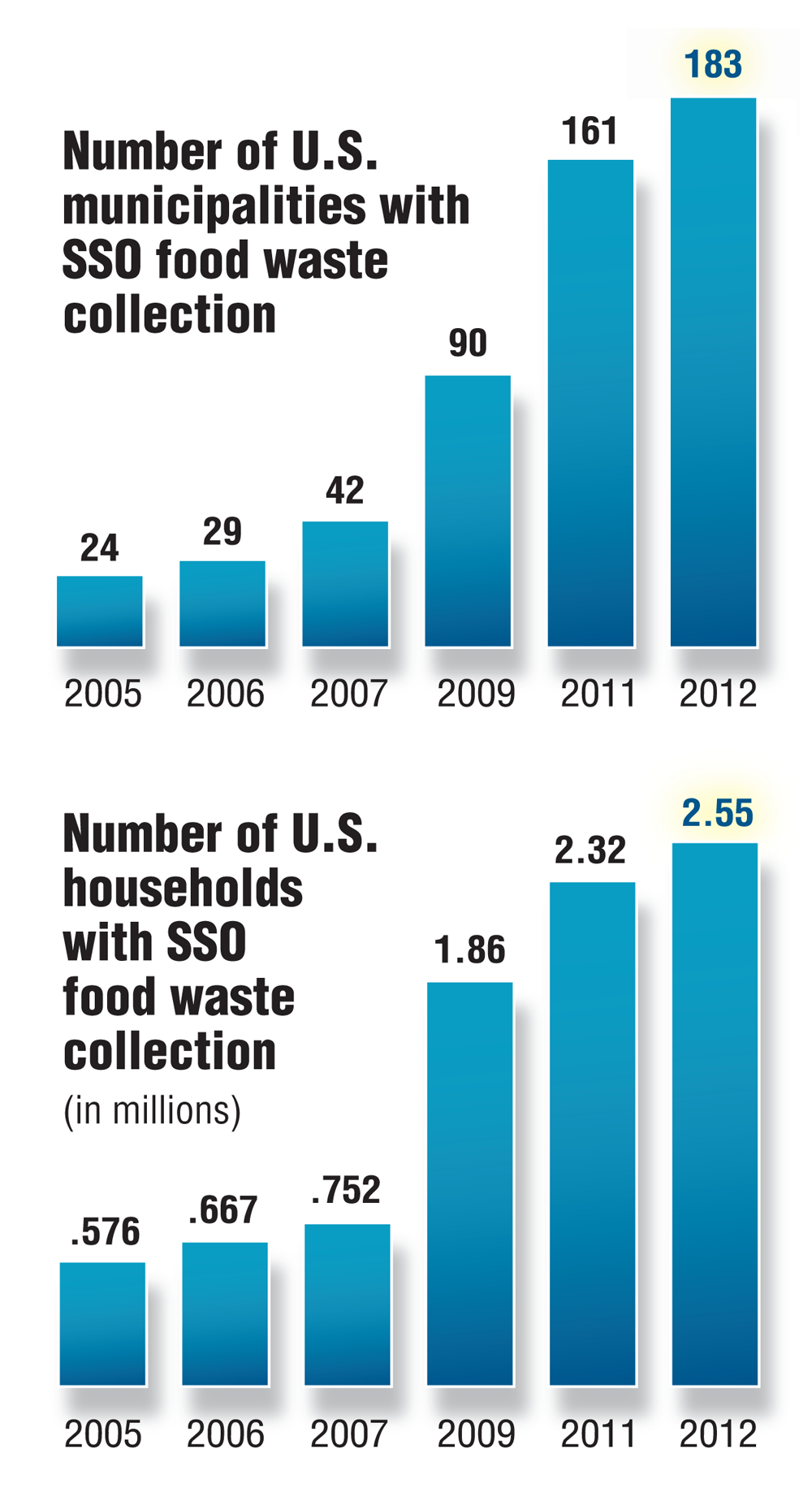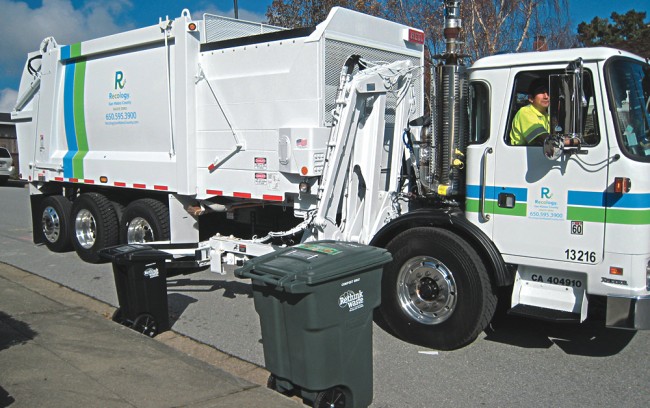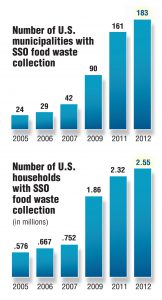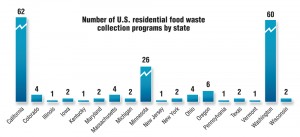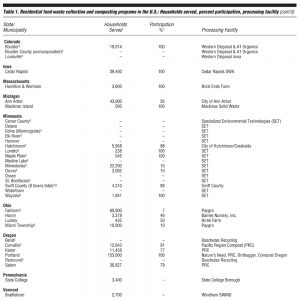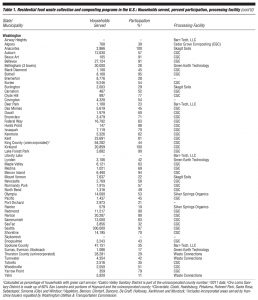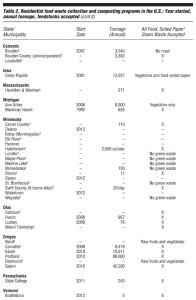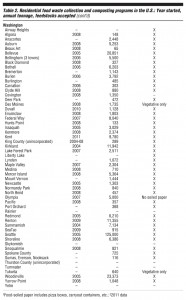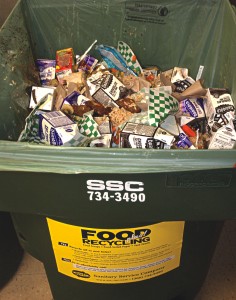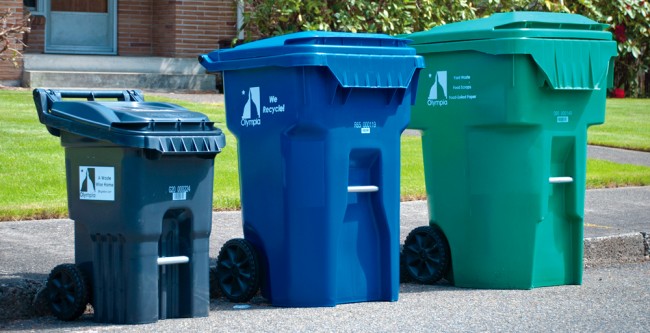Growth of residential food waste collection in the U.S. is steady, with existing programs seeking to increase household participation.
Rhodes Yepsen
BioCycle March 2013, Vol. 54, No. 3, p. 23
This expanded online version includes expanded tables with additional program details as well as additional information about municipal programs.
Click here to download a pdf of this article (includes additional tables).
Residential, commercial and institutional food waste diversion programs continue to pop up around the U.S., but still only make a small dent in the amount of food waste going to landfills and incinerators (still the #1 material disposed in the U.S.). This BioCycle survey looks specifically at municipalities that are aiming to divert the residential organics portion of the MSW stream by offering households curbside collection of food waste. There are also several communities with successful municipal drop-off programs for food scraps, and a dozen or more private haulers who provide household food scraps service (several of which use alternative methods of collection like bicycles).
Looking at past surveys, the growth trajectory for residential food waste collection has been strong, both in terms of the number of municipalities offering the service, and the number of households with access. However, the data for 2012 shows this trend tapering off, at least for the time being. This is due to several factors. First, the survey is now annual, whereas the data from previous queries was spaced out every few years, which means the timeline has changed. Projects can take 6 months to a year to come to light, so there are likely several that have been missed. Also, most pilot projects lead to full programs, but not all. A few that ended have balanced out the new programs that recently came online.
This survey was conducted in the last quarter of 2012, supplemented with data received in early 2013. BioCycle has identified 183 communities offering curbside collection of residential food waste, spread out over 18 states (a warm welcome to New York and Vermont). These programs reach over 2.55 million households, which represents a jump of about 200,000 — a sign that communities continue to expand the reach of their services, with many looking at multiunit buildings. The total amount of organics diverted through these programs in 2012 (yard trimmings and food waste), based on about 79 percent providing this data, is 726,250 tons.
Beyond adding more households, communities with source separated organics (SSO) collection are increasingly looking at ways to boost participation (putting any amount of food waste in the green cart), and improve capture rates (higher percentage of available food scraps and soiled paper entering the green cart, instead of the trash). For most of the population, separating food scraps in the kitchen requires a major behavior change, and achieving high capture rates requires careful planning.
The majority of residential programs are located on the West Coast, where food waste has been added to existing yard trimmings programs. This has several advantages, such as building on the initial investment in green carts, trucks, etc. Also, a composting facility contract is already in place (although likely would need a new permit). However, there are some initial disadvantages to simply telling residents they can now place food scraps in with the yard trimmings. Just as with conventional recycling, people need things explained clearly, including detailed instructions on how and why to participate, including appropriate tools and incentives. Also, it can be difficult to monitor food waste capture rates when it’s a small percentage mixed in with mostly yard trimmings.
Increasing Participation
To boost participation and capture rates, communities are looking at several tactics, some more aggressively than others. Providing a financial incentive for recycling and composting, primarily through Pay-As-You-Throw (PAYT) pricing structures, has been successful. With PAYT, residents can save money on monthly bills by reducing the size of their trash can. Creative communication campaigns, with ads on TV, radio and sides of collection vehicles, help remind people that it’s cool to recycle and compost, and emphasize how much of their kitchen waste is actually not garbage. Communities are also encouraging use of tools like kitchen pails and compostable bags, making it simple, quick and tidy to start collecting food scraps. At last count, 78 percent of the U.S. programs allow or promote the use of BPI-certified compostable bags.
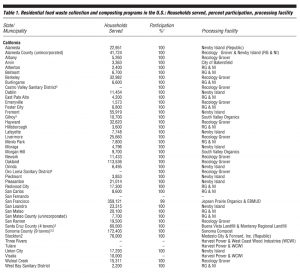
Table 1. (part 1) Residential food waste collection and composting programs in the U.S.: Households served, percent participation, processing facility
Table 1 and Table 2 summarize information about the states and communities with ongoing residential food waste collection service. More details about these programs are provided below. Tables 3 and 4 list the communities or counties with pilot projects.
California
Arvin: The city of Arvin has been collecting residential food scraps and food-soiled paper (everything except meat) mixed in with yard trimmings since 2006. Trash and organics are collected weekly from over 3,300 households, with recycling collected every other week. The organics are currently composted at the City of Bakersfield’s municipal facility. Bakersfield has an active program for commercial, institutional and industrial food waste, but doesn’t currently allow residents to place food scraps in the green bin, contrary to what was published last year. “The amount we receive from Arvin is relatively small, compared to what we would have from the roughly 100,000 households in Bakersfield,” says Kevin Barnes, Director of Solid Waste at the City of Bakersfield. “We will likely accept residential food waste in the future, but need to retool our process first. We currently have automated carts with green waste, and have to prescreen for reject material using manual sorting prior to our high-speed hammermill. Food waste could bring worker safety issues, so we would switch to a low-speed shredder that can tolerate hazards that would ruin the high-speed, and stop manual sorting.” Bakersfield is currently at 62 percent diversion, and Barnes notes that the driver for residential food waste will either be green awareness, a social push, or the CalRecycle directives for diversion.
“The contest is still running and in November it became a year-round program,” says Jeff Becerra, Communications Manager for StopWaste.org. “Since November we’ve conducted almost 300 garbage cart sorts. The overall trend is showing less compostables and recyclables in the garbage cart now (36 percent by weight) versus 2011 (42 percent). We need to get more sorts done over the next six months to get a proper comparison to the 2011 data.”
Central Contra Costa: The Central Contra Costa Solid Waste Authority (CCCSWA), located in the eastern San Francisco Bay Area, services approximately 62,500 households with food scraps collection (the 4 jurisdictions with service are listed individually in Table 1). All food scraps are permitted with yard trimmings, including grease and sauces. Based on walking audits, about 35 to 40 percent of residents place food scraps in the cart on a weekly basis. Residents are given a two-gallon kitchen pail when signing up for service, and are permitted to use BPI-certified compostable bags. All material streams are collected weekly. The residential organics program is also available to multiunit buildings. In 2012 a marketing test was conducted to determine methods for boosting participation. “The results were inconclusive,” reports Bart Carr, Senior Program Manager at the CCCSWA. “In some communities, participation went up while in others they remained flat or went down. The cost of using mailers and/or cart hangers considering these results make expansion of this not feasible at this time.” Central Contra Costa is planning for a new long-term franchise to begin in March 2015, in which all communities (including Danville and unincorporated areas) will receive residential food scrap collection. Future marketing efforts will focus on encouraging more residents in all communities to recycle their organic wastes.
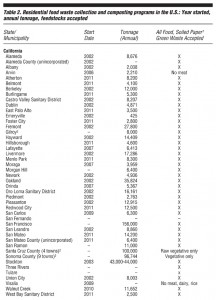
Table 2. (part 1) Residential food waste collection and composting programs in the U.S.: Year started, annual tonnage, feedstocks accepted
Palo Alto: The city of Palo Alto has announced it will implement an SSO pilot project starting in April. About 600 single-family and 80 multiunit households out of the city’s 17,700 households will be included in the pilot. The pilot will be a total divergence from the existing services, eliminating the black trash cart and switching to a two-cart system: Blue Cart (loose recyclables plus bagged trash, including bathroom/pet waste and nonrecyclable materials) and Green Cart (loose yard trimmings plus bagged food scraps and food soiled paper). Residents will be given a kitchen pail and compostable bags, and the organics will be sent to Z-Best in Gilroy. “They have an extensive screening system,” says Matt Krupp, Zero Waste Administrator for the city of Palo Alto. “The hope is that bagging the food scraps and food soiled paper in compostable bags will assist in keeping the more contaminated material from the very clean yard trimmings.”
The pilot will evaluate cost, convenience, diversion rate from landfills, quality of materials and truck trip reductions. It will help determine the degree to which the cost of weekly compostables collection can be offset by reducing the collection frequency of garbage. The city estimates that 44 percent of the residential waste stream is compostable.
Santa Cruz County: The organics program in Santa Cruz County is still predominantly commercial food waste. Residents are permitted to place raw fruits and vegetables in their green carts, but it’s not overtly promoted. “About 60,000 households have green carts between all jurisdictions, but we don’t encourage using them for food scraps,” says Tim Goncharoff, Resource Planner for Santa Cruz County Public Works. “We do allow garden waste, so, for example, an apple that falls from your tree is allowed, but not one you bought from the store. A subtle distinction, we realize.” They expect to add a full residential food waste program within the next five years.
San Francisco: The city of San Francisco has been a leader in residential food waste collection, and now 99 percent of its households have green cart service. “In three months we will have 100 percent compliance with our Mandatory Recycling and Composting Ordinance,” reports Alexa Kielty, Residential Zero Waste & Special Projects Assistant for SF Environment. “Out of the 8,500 apartment buildings (6 units and above) 8,000 building have the composting program. We are continually sending out folks in our Environment Now green job training program into the field to conduct ‘door-to-door’ outreach in the multifamily building sector.” Recology now collects over 600 tons/day from households and businesses (Monday through Friday), composted at its Jepsen Prairie Organics facility in Vacaville.
San Mateo County: There are approximately 93,000 households with food scraps collection in San Mateo County’s 12 member agencies. The first to start was San Carlos in 2009; the remainder came online in 2011 when new contracts were signed. About 89,000 tons of residential organics and 20,000 tons of commercial are collected annually, sent to Recology Grover and Newby Island for composting. . “We do our own quarterly sampling of contamination, and it has ranged from 1.6 to 14.67 percent for commercial, and 1.1 to 5 percent for residential,” says Monica Devincenzi, Recycling Outreach & Sustainability Manager for RethinkWaste. “Our service area residential diversion rate based on the collection services (recycling and organics) is approximately 67 percent.”
Colorado
Boulder/Louisville: About 33,000 households have food scraps collection in the cities of Boulder and Louisville, as well as unincorporated Boulder County. All single-family households in the city of Boulder have organics and recycling collection (required as part of trash service) as well as about 63 multiunit properties. A PAYT fee structure provides an incentive for participation, and compostable bags are promoted, but kitchen pails are not distributed. Organics are composted primarily at Western Disposal, with some going to A1 Organics.
Denver: The city of Denver has been collecting residential food waste since 2008, when it launched a pilot program for 3,000 households, funded by a grant. In 2010, the program transitioned to a subscription service ($9.75/month), and about 2,300 households remained. All food wastes are permitted, collected weekly and composted by A1 Organics. Contamination remains quite low (about 1 percent).
Iowa
Cedar Rapids: Residents have been allowed to place vegetative food scraps in their yard trimmings cart in Cedar Rapids since 2001. “We started offering residential food scrap service in 2001, after we came back from Europe where we observed in-vessel digestion and then saw other U.S. windrow composting operations successfully incorporating fruit and vegetable organics into their compost operations,” recalls Mark Jones, Superintendent of Solid Waste and Recycling for Cedar Rapids. “I thought, why not allow residential customers the opportunity to place fruit and vegetable peelings into their YARDY carts along with other items such as pet and human hair clippings, paper plates and napkins and coffee grounds, tea bags and vacuum cleaner bag contents.” They are given a 35-gallon trash cart as part of the monthly fee, and must pay extra for additional garbage. A permit restriction only allows 2 tons/week of food waste at the composting facility. To expand the program for all residential food scraps, which Jones expects will happen in the next 3 to 5 years, a permit change would be required for the composting facility.
Dubuque: The food scraps pilot program is status quo in Dubuque, where about 250 households subscribe for $0.60/month. Participants are given a kitchen pail and a small curbside cart, with weekly collection. Like Cedar Rapids, a permit restriction only allows 2 tons/week of food waste at the composting facility; food waste from businesses comprises the remaining food waste received.
Illinois, Kentucky, Maryland
Oak Park, IL: Located just west of Chicago, the town of Oak Park piloted residential food waste collection in 2012, and plans to roll out the service to all 12,500 households in 2013. Collection is weekly, mixed with yard trimmings, and is composted at Land and Lakes. The cost to households is $12/month, which is less than the cost of one “yard waste” sticker and bag per week, which residents must purchase for the standard yard trimmings program. Oak Park has a PAYT price structure, allowing residents to recoup some of the cost of the service by reducing their trash cart from 96 gallons to 64 gallons. Residents have been positive about the pilot program, with many reporting that they were able to switch to the smaller garbage cart, and several suggested a smaller organics cart (currently 96-gallons), saying that it was not necessary unless a lot of branches had fallen off the trees.
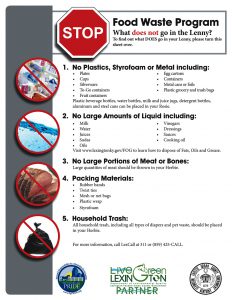 Lexington, KY: The city of Lexington continues to pilot food waste collection for about 400 households, which began in 2011. The city is currently at 40 percent waste diversion and has a goal of zero waste by 2020; food waste collection will be key to the success. “We would like to expand the pilot project to 2,000 homes, as a zero waste neighborhood,” says Esther Moberly, Recycling Program Specialist for the city of Lexington. “The project would allow residents to place food waste in the yard waste container, more recyclables in the recycling container, and measure how much landfill bound waste is reduced. We are also considering adding a Pay as you Throw component to the project, giving the residents the ability to choose between 35 gallon, 65 gallon or keeping the 95 gallon one they have now.”
Lexington, KY: The city of Lexington continues to pilot food waste collection for about 400 households, which began in 2011. The city is currently at 40 percent waste diversion and has a goal of zero waste by 2020; food waste collection will be key to the success. “We would like to expand the pilot project to 2,000 homes, as a zero waste neighborhood,” says Esther Moberly, Recycling Program Specialist for the city of Lexington. “The project would allow residents to place food waste in the yard waste container, more recyclables in the recycling container, and measure how much landfill bound waste is reduced. We are also considering adding a Pay as you Throw component to the project, giving the residents the ability to choose between 35 gallon, 65 gallon or keeping the 95 gallon one they have now.”
One unique aspect of Lexington’s program is a partnership with the local nonprofit Bluegrass PRIDE, which specializes in community education and outreach. The city contracts with them to work on education for residents, door-to-door visits, presentations, etc. As Lexington moves into more widespread food waste collection, they will continue to work with Bluegrass PRIDE.
Howard County, MD: Located just to the west of Baltimore, Howard County began offering residential food waste collection service in 2011. The program continues to serve about 5,000 households, with 1,000 subscribed. “The program has not expanded due to budget constraints during the past year,” says Alan Wilcom, Howard County’s Recycling Manager. “I have requested a small expansion for the upcoming Fiscal Year (July-June).” The program doesn’t currently allow meat/fish in the 35-gallon green cart, but still manages to collect about 9 lbs/week/household organics, which are now composted at Wilmington Organic Recycling Center (WORC). The county is constructing its own composting facility to receive the food waste, which is scheduled to be open in April.
Massachusetts
Cambridge: The Massachusetts Department of Environmental Protection has established significant goals to reduce trash, and the City of Cambridge has adopted them — reduce tons disposed by 30 percent by 2020 from 2008 levels, and by 80 percent by 2050. The city of Cambridge has a long-standing residential drop-off program, allowing households without backyard compost piles to bring food scraps to the Recycling Center and the Farmers Market. At the end of 2012, Cambridge City Council approved a pilot project for curbside collection of food scraps. The pilot is to start no later than April 2014, and will include up to 800 households. Participation will be voluntary, offered to both single-family homes and buildings with up to 12 units. The pilot will last for one year, and will likely focus just on food waste — tip fees are much lower for separate loads of yard trimmings. Participants will be given a kitchen container, a year’s supply of compostable bags, and green curbside bin. If the pilot program is successful, city staff envisions gradually expanding it citywide as a voluntary program, adding collection days to establish route density.
Hamilton: The town of Hamilton piloted residential food waste collection in 2008, and then decided to roll out the program to all 3,600 households, including in the sister city of Wenham in 2011. In a survey conducted in September 2012, approximately 44 percent of residents were participating in the organics program. In April there are plans to provide a small questionnaire to residents who are not participating in the program to learn more. “During the 9 months since the organics program was implemented full-scale, solid waste tonnage went down 522 tons, recycling went up 201 tons and an additional 231 more tons of organics waste was collected,” reports John Tomasz who was formerly the Superintendent of Hamilton Public works, but has since moved on to the city of Salem. “A total of 271 tons of organics was collected last year vs. 42 the year before.“ Overall, the town saved approximately $25,000 in disposal savings with the new organic program, and the recycling rate went from 32.6 to 50.3 percent.
Ipswich: The town of Ipswich’s pilot started in 2011 and is ongoing, collecting 15 lbs/week/household, composted at Brick Ends Farm. “We have very positive feedback from residents,” says Judy Sedgewick, Recycling Coordinator for Ipsiwch. “We are in the planning phase for our next cycle and may keep things as is but would prefer to offer the service through the town with the town contributing to the cost instead of it being fully paid for by the residents (currently $8/month for 20-gallon cart). Price keeps our numbers at around 200 participants in our town of 5000 households. We have also increased the number of people composting in their backyards, which is not reflected in the numbers.”
Michigan
Ann Arbor: The city of Ann Arbor began collecting residential organics in 2006, and now has a widespread program, with about 11,000 “subscribers” out of 43,000 households. Residents must purchase the cart, and then the service is covered by taxes for garbage service. Only vegetative food wastes are currently permitted, mixed with yard trimmings, collected seasonally (April-December). “We are finalizing our draft Solid Waste Plan, and hope to have City Council approval in April,” reports Tom McMurtrie, Solid Waste Coordinator for Ann Arbor. “The plan includes a proposal to expand our program to include all types of food waste, and to encourage more residents to participate.” WeCare Organics now manages the municipally owned composting facility.
Mackinac Island: No major changes for the food scraps program on Mackinac Island were reported. The Island has been collecting from residences since 1992. The historic island doesn’t allow cars, so collection is done using horse-drawn trailers. Organics are collected in compostable bags (residents are charged per bag), and composted at the municipal facility on the island. They continue to collect about 635 tons of food waste from residences and businesses, along with 500 tons of yard trimmings and 4,500 tons of manure. The island is at about 50 percent waste diversion.
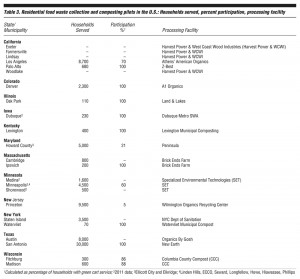
Table 3. Residential food waste collection and composting pilots in the U.S.: Households served, percent participation, processing facility
Minnesota
“We are getting closer to publishing the final version of our SSO compost facility rule amendment,” reports Ginny Black with Minnesota Pollution Control Agency (MPCA). “It is currently scheduled to happen late summer or early fall and closely follows the US Composting Council’s Model Rule Template.” A new Solid Waste Metro Plan sets aggressive diversion goals, including some for organics recovery. “The plan calls for the metro area to recovery 9 to 15 percent of the waste stream via organics recovery by 2030,” explains Tim Farnan, also with MCPA.
Blue Bag Organics, part of Randy’s Sanitation, works with municiaplities in Hennepin and Carver counties in the Twin Cities region on food waste collection. Randy’s had been offering separate collection of food waste, but the Blue Bag program takes advantage of the efficiencies of cocollection. Subscribers are given a kitchen pail and small compostable liners, along with 60 large 32-gallon blue compostable bags. All food and soiled papers are allowed, but not yard trimmings. The blue bags are put in the trash cart and cocollected with the weekly garbage service, sorted out at a transfer station and then sent to Specialized Environmental Technologies for composting.
Hennepin County: No major changes to the residential food scraps programs in Hennepin County are reported. Several towns continue to offer service to residents. The first to offer service was Wayzata in 2005; Shorewood launched a pilot project in 2012.
Hutchinson: The city of Hutchinson’s program continues to serve about 6,000 households. Hutchinson is one of the few programs to provide compostable bags to residents at no cost (the typical European model). Biweekly garbage collection is offered as part of an aggressive PAYT fee structure. It is credited with bringing the city high participation and low contamination. Hutchinson also offers biweekly garbage collection as part of an aggressive PAYT fee structure. The organics are composted at CreekSide, a municipal composting facility that has a successful line of bagged compost.
New Jersey, New York
Princeton, NJ: Princeton piloted a food waste collection subscription service starting in 2010, a program that grew to about 450 households last year. Organics are collected weekly and trucked to the Wilmington Organics Recycling Center in Delaware (WORC) for composting. In January, the town passed an ordinance regulating the fee for participation, previously $20/month, reducing costs for residents to $65/year. Last year Princeton was awarded a $20,000 grant from Sustainable Jersey to help promote the food scraps program. Sustainable Princeton will administer the grant, and says it aims to grow participation to 1,500 households within an 18-month period (Princeton has about 9,500 single-family households).
New York, NY: The active Greenmarket composting program in New York City reached a milestone, announcing in January that it had collected over one million pounds of food scraps from businesses and residences. While that popular program will remain, the City’s Department of Sanitation is moving forward on an initiative to collect organics curbside from single-family homes, starting with a pilot on Staten Island scheduled to begin this May. “We are starting in a neighborhood area of single family homes, collecting food scraps in a 12-gallon bin on recycling day,” says Bridget Anderson, Director of Recycling Unit for NYC’s Department of Sanitation. “All food wastes and soiled paper will be permitted, composted at our municipal facility on Staten Island. We hope to see good participation and low contamination so that we can expand.”
WeCare Organics currently operates the Staten Island composting site. “We have successfully processed food waste at the site in the past and we look forward to working with the City as they expand their organics diversion program,” notes Brian Fleury, Senior VP, Organic Residuals, at WeCare Organics. “As the program grows, we will be looking at various operational and technological modifications in order to maximize the efficiency and capacity of the facility while continuing to focus on manufacturing a high-end compost product.”
Watervliet, NY: The Town of Watervliet launched a small pilot program in January 2012 to test collection of residential food waste from 50 households. Residents were given a kitchen pail, compostable bags, and a small 13-gallon cart to collect just food waste. About 5 lbs/week/household were collected. “We had a lot of positive feedback, with some households reporting zero waste: only organic and recyclables,” says Mike Manning, Mayor of Watervliet. “The only rough spot was in really warm weather, where we had to go to weekly instead of biweekly collection.”
During the first months of the pilot, the food waste was taken to the Albany Wastewater Treatment Plabt and run through a small-scale digester (.5 tons/day capacity), mixed with biosolids and FOG (fats, oils, grease). The food waste is now being composted at the municipally owned facility. Watervliet Mayor Mike Manning hopes to eventually roll the program out to all 2,500 households currently on garbage service (a population of 10,200). About 100 households will be added in 2013. They are in the process of developing an anaerobic digester, with the aim of bringing on local businesses and schools in addition to residences, and producing natural gas for heating and/or city vehicles.
Ohio
Huron: The residential organics program in Huron is available to all households (about 3,400) on a subscription basis. All food scraps are accepted, collected weekly and composted at Barnes Huron Composting Facility. Residents must provide their own cart and kitchen pail. Last year 957 tons were collected, of which about 10 percent is estimated to have been food scraps. Huron is currently diverting over 60 percent of its waste.
Luckey: The “compostable recycling” program in Luckey was launched in 2009, when a failing conventional recycling program in the small town was replaced by composting. All paper, even traditionally recyclable items, are accepted in the weekly green cart service, along with all food scraps. They are collected by N.A.T. Transportation and composted at Hirzel Farm. About half of the 435 households on garbage service currently subscribe. Bottles and cans are collected monthly.
Oregon, Pennsylania
Marion County, OR: The cities of Salem and Kaizer have been collecting residential food scraps since 2010, with service offered to about 48,000 single-family households. The communities have weekly collection of trash and organics, and biweekly recycling collection. A PAYT pricing structure allows residents to reduce their trash cart to 20-gallons. All organics are permitted in the green cart, but compostable bags are not, as specified by Pacific Region Compost. “We will be increasing the level of advertising of this program to the Latino community which makes up nearly 25 percent of our area’s population,” says Beth Myers-Shenai, Waste Reduction Coordinator for Marion County. “We recently produced a funny TV spot in Spanish, to mirror our English one, which will be included along with radio, print and hopefully billboards. We have also been rolling out a food waste composting program in all Salem-Keizer schools elementary schools over this 2012-13 school year, so our plan is to increase our outreach efforts to the entire community this summer to reinforce at home what the students have been learning in school.”
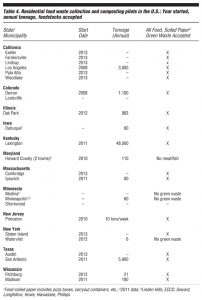
Table 4. Residential food waste collection and composting pilots in the U.S.: Year started, annual tonnage, feedstocks accepted
Portland, OR: The city of Portland piloted residential food waste collection in 2010 and went citywide in 2011. All 345,000 single-family households (up to four units) now have green carts, along with an aggressive PAYT system where every-other-week trash collection is the standard. Organics are composted at several composting facilities in the area, including Pacific Region Compost (Benton County), Nature’s Needs (North Plains), Compost Oregon (Aumsville), and Dirthugger (Hood River). Contamination is at about 2 percent. About 9 out of 10 composting roll carts at the curb contain food scraps, according to a field study conducted last fall. Assuming that customers whose carts were not at the curb during the study are not participating in the program, the study indicates that at least 78 percent of customers are placing food scraps in their green Portland Composts! Based on a waste audit, the city determined that it’s capturing about 45 percent of the available organics from the MSW stream.
“We are wrapping up a research project on buildings with five or more units to identify best practices for working with multifamily buildings,” says Arianne Sperry, with the city’s Bureau of Planning & Sustainability. “We’re also looking into ways to improve service to renters in single-family homes and small multiplexes. Renters often miss out on important communication or don’t have as much control over their service options. Other than that, our focus is primarily on continuing to increase participation in our curbside food scrap collection service.” Overall, Portland is at 70 percent waste diversion, and has goals of 75 percent by 2015, 90 percent by 2030.
State College, PA: Pennsylvania’s lone residential food waste pilot in State College, started in 2010 with around 560 households, is expanding to the entire Borough in April (3,400). “Organics will be bundled with the trash and other recycling service through the Borough Public Works Department at no additional charge,” reports Joanne Shafer, Deputy Director/Recycling Coordinator for Centre County Solid Waste Authority. “Residents will be able to opt out of organics collection if they wish. Many people we surveyed with in-sink garbage disposals said they would discontinue use of their disposal to participate in the program. The participation rate has been far beyond our initial projections. Concurrent with the residential pilot, we have included some varied commercial properties.”
As part of the rollout, residents are receiving new trash carts because the Borough is automating collection of both refuse and organics. “Kitchen collectors are being issued with the organics carts at no charge,” explains Edward Holmes, Public Services Manager for State College Borough. “Our trash rate structure will be reviewed later this year in a refuse study that will look at rate structures among other things in both residential and commercial collection.” All food scraps, including meat, are now permitted in the program, as are compostable bags.
Texas, Vermont
Austin, TX: The Austin City Council approved a Resource Recovery Master Plan in December 2011, creating a roadmap to Zero Waste, and committing the city to reducing the amount of waste sent to landfill. The city currently diverts 38 percent of its waste, but has set goals for 50 percent by 2015 and 75 percent by 2020.In January 2013, an 8,000 household pilot was launched for residential food waste. Participants were given a kitchen pail and a 96-gallon green cart for yard trimmings and food waste. Organics are collected weekly and composted at Organics By Gosh. The city plans to have the program adopted citywide by 2016, building off of experiences from the pilot stage.
San Antonio, TX: The City of San Antonio continues to maintain a 30,000-household pilot project for residential food waste collection that started in 2011. Food scraps are commingled with yard trimmings. They collect about 8 lbs/week/household, the majority of which is yard trimmings, composted by New Earth. All materials are collected weekly, and contamination remains low (about 2 percent). The city plans on expanding the program citywide later this year as a voluntary, subscription-based service. “The proposed plan for organics is to offer the program as a subscription based service for a proposed fee of $3/month starting Oct. 1st, 2013,” says Nick Galus, Sr. Project Manager for the City’s Solid Waste Management Department. “We will maintain the pilot program through the first half of this year until we start making the transition to the subscription based service. Emphasis will be placed on encouraging residents to subscribe.”
Brattleboro, VT: The city of Brattleboro piloted a curbside food waste collection program in August 2012, and is expanding it citywide (2,700 single family houses) in April this year. It will be a subscription program, costing $10 to subsidize the cost of the curbside cart, with remaining costs funded by taxes. Pilot participants received compostable bags, a kitchen pail and a curbside cart (various manufacturers donated different styles of bags and carts). For the full-scale program, Brattleboro issued an RFP for curbside carts ranging between 12 to 22 gallons; residents may provide their own container, provided that it’s not over 32 gallons. The smaller cart size is due to the focus on food, rather than green waste. “Food waste made up over 90 percent of the organics collected during the pilot,” says Moss Kahler, Brattleboro Recycling Coordinator. “The town offers a leaf and yard waste pick up two times per year (spring and fall). While all food waste is permitted [in the new program] only incidental yard trimmings can be included. Also, if we supply carts larger than necessary, many folks will not put them out every week (as they will be nowhere close to full) and that will result in maggot, slime and odor issues.”
Participation in the pilot was 85 to 89 percent, with less than 1 percent contamination. Besides the kitchen pails and compostable bags, Kahler explains this was because residents had to subscribe (showing interest), and the town was extremely active with email communications, making it clear what was permitted in the new cart. On average, households during the pilot placed 10 to 12 lbs/week in the organics cart. So far, about 400 households have signed up for the program. In the future, Brattleboro will make the program mandatory, and look into PAYT pricing. The state of Vermont passed a law in the summer of 2012 phasing in a ban on landfilling organics, which will push other towns to set up programs as well.
Washington
Bellingham: About 30,000 households in the Bellingham area have access to FoodPlus!, offered by Sanitary Service Company, Inc. (SCS). The subscription-based program has roughly 8,500 households currently signed up for the every-other-week organics (EOW) service, many of whom also have every-other-week trash collection. “We continue to simply not have any issues with EOW collection,” reports Rodd Pemble, Recycling Manager for SCS. “I’m sure a large part of that is few other cities have so many people on every-other-week (about 50 percent) or monthly (about 32 percent) garbage as we do and have for almost 20 years. Our customers are already used to it, so EOW compost collection is not an issue.” Heat is not a concern in the Pacific Northwest he says, and wildlife has only been an issue for overfilled garbage carts, which attracts raccoons and crows. Organics are typically taken to a transfer station before being hauled to Green Earth Technology, unless a route is close enough to the composting facility already.King County: “King County Solid Waste Division collects hauler data from all cities and has commissioned studies to determine how much food is in yard waste carts countywide,” says Bill Reed, with King County Solid Waste Division. King County has 38 jurisdictions with residential food scraps collection, implemented between 2004 and 2011, covering over 300,000 households (not including Seattle, which operates separately). Based on 2011 data, participants of the food scraps program are capturing 13.1 percent of available food from the MSW stream. An average of 2.1 pounds per participating household are set out each week, about 7.7 percent of which is estimated to be food (with the remainder being yard trimmings). Organics are composted at Cedar Grove’s facilities in Maple Grove and Everett. The town of Renton continues to be the only one offering EOW garbage collection.
Olympia: The city of Olympia piloted residential food waste collection in 2007, and currently offers service to all 14,000 households, of which about 7,400 subscribe. Service is also available to multiunit buildings. “All 130 complexes can subscribe, but the majority don’t,” says Ron Jones, Senior Waste Reduction Specialist with the City. “We estimate that 30 complexes currently have food waste collection, or about 1,500 to 2,000 households, but only a small percentage actually use the program (put food in the bin).”All materials are collected every-other-week and processed at Silver Springs Organics, now owned by Waste Connections, which has brought about changes for the program. Silver Springs announced recently that they will no longer accept food-soiled paper or most compostable products (besides compostable bags).
Seattle: The city of Seattle began collecting residential fruits and vegetables in 2005, and has grown the program over time. Currently, all households with garbage service are required to have organics collection, including multiunit buildings, unless they apply for an exemption (single-family households can be exempt if they practice backyard composting; multifamily buildings can be exempt if they have space constraints). In 2011, the city collected 78,768 tons of residential organics, 43 percent of which was food waste. An estimated 16,000 tons of organics were composted in backyards. When the city last did a waste composition study (as part of the 2010 comprehensive plan), it looked at how much and what types of food waste were being captured from the MSW stream, and found a 45 percent capture rate for the residential sector.
Wisconsin
Fitchburg: The City of Fitchburg began a pilot project in April 2012, collecting food waste from about 250 households. Participants were given a 35-gallon curbside cart, kitchen pail and compostable bags, with organics collected weekly and sent to Columbia County’s mixed MSW composting facility. The pilot was able to achieve about 50 percent capture rate for organic wastes, averaging 18 lbs/week/household (including pet waste). “We recently sent out letters to about 100 new households inviting them to participate starting in April 2013,” says Rick Eilertson, Environmental Engineer with the city of Fitchburg. “City sponsorship of the pilot will likely end in December 2013, but we’re hoping to get our hauler, Pellitteri Waste Systems, to offer a subscription based service to interested households.” The city is in the process of getting a composting operation approved/permitted at the Public Works Maintenance Facility for handling the SSO and yard trimmings.
Madison: In 2011 the city of Madison began piloting residential food waste collection, and has continued offering the service, currently to about 550 households. Madison is getting about 13.8 lbs/week/household of organics, which is a 58 percent capture rate. In an attempt to capture the maximum amount of putrescible waste, the city is currently allowing pet waste and diapers in the organics cart, which are sufficiently screened out at the Columbia County mixed MSW composting facility. The city also has a robust backyard composting program, having sold over 25,000 backyard bins over the last 18 years, and plans to expand the organics program in 2013 to include supermarkets. As part of the Madison’s plans for building an AD facility to handle all of the organics, Recycling Coordinator George Dreckman toured 10 anaerobic digestion facilities in Europe in 2012, looking at how communities are processing residential and commercial food waste and yard trimmings. Madison is already at a 73 percent diversion rate, and has goals of 75 percent by 2015, and 85 percent by 2020.
Rhodes Yepsen, Marketing Manager for Novamont North America, was formerly an editor at BioCycle. Since 2007 he has conducted the BioCycle nationwide survey, “Residential Food Waste Collection in the U.S.”


